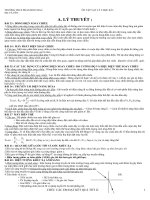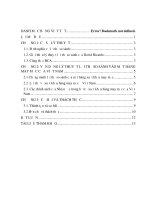En43 lý thuyết dịch Đề số 3
Bạn đang xem bản rút gọn của tài liệu. Xem và tải ngay bản đầy đủ của tài liệu tại đây (44.26 KB, 4 trang )
<span class="text_page_counter">Trang 1</span><div class="page_container" data-page="1">
<b> MID -TERM TEST ON TRANSLATION THEORIES </b>
<small>FOR STUDENTS OF ENGLISH (No 3) </small>Subject Code: EN43
<b>Full name: Date of birth: </b>
<b>I. Answer the following questions: (40 points)</b>
1. What are Nida's Linguistic Theories of Translating?
2. What are Nida's Sociolinguistic Theories of Translating? (The file sent will be named after each student’s name. Plagiarism will lead to failure)
<b>1. Nida's Linguistic Theories of Translating: Eugene A. Nida, a prominent figure in the</b>
field of translation studies, developed several linguistic theories that have significantlyinfluenced translation practice. Some of Nida's key linguistic theories of translatinginclude:
<b>a. Dynamic Equivalence: Nida introduced the concept of dynamic equivalence, which</b>
suggests that the translator's primary goal is to convey the message and meaning of thesource text (ST) in a way that is natural and idiomatic in the target language (TL), ratherthan adhering strictly to the form or structure of the original text. This theory emphasizesthe importance of the target audience's understanding and cultural context in translation.
<b>b. Functional Equivalence: Building on dynamic equivalence, Nida proposed the</b>
concept of functional equivalence, which focuses on achieving equivalent communicativefunctions between the ST and the translated text in the TL. This theory emphasizes theimportance of achieving the same effect or response in the target audience as intended bythe source text, even if the linguistic forms differ.
<b>c. Componential Analysis: Nida advocated for componential analysis as a method for</b>
analyzing the meaning of words and phrases in translation. This approach involvesbreaking down linguistic elements into their component parts and examining theirsemantic features and relationships. By understanding the underlying components ofmeaning, translators can make more informed decisions about how to convey theintended message accurately in the target language.
</div><span class="text_page_counter">Trang 2</span><div class="page_container" data-page="2"><b>2. Nida's Sociolinguistic Theories of Translating: In addition to his linguistic theories,</b>
Nida also contributed to the field of translation studies through his sociolinguistictheories, which consider the social and cultural factors that influence the translationprocess. Some of Nida's sociolinguistic theories of translating include:
<b>a. Cultural Equivalence: Nida emphasized the importance of achieving cultural</b>
equivalence in translation, which involves not only conveying the meaning of the sourcetext accurately but also preserving the cultural nuances, values, and norms embedded inthe original text. This theory highlights the role of culture in shaping language andcommunication and underscores the need for translators to be culturally sensitive andaware.
<b>b. Audience Analysis: Nida stressed the significance of audience analysis in translation,</b>
suggesting that translators should consider the characteristics, preferences, andexpectations of the target audience when producing translated texts. By tailoring thetranslation to the needs and cultural background of the intended audience, translators canensure that the message is received and understood effectively.
<b>c. Sociolinguistic Variation: Nida recognized the importance of sociolinguistic variation</b>
in translation, acknowledging that language use can vary depending on social factors suchas age, gender, ethnicity, and socio-economic status. Translators must be sensitive tothese variations and adapt their language choices and strategies accordingly to producetranslations that are appropriate and meaningful to diverse audiences.
<b>II. Translation practice </b>
<b>1. Read the text and find out the features of the situational context (30 points)</b>
... He was a comely handsome fellow, perfectly well made, with straight, stronglimbs, not too large, tall, and well shaped; and as I reckon, about twenty six years of age.He had a very good countenance, not a fierce and surly aspect, but seemed to havesomething very manly in his face; and yet he had all the sweetness and softness of aEuropean in his countenance, too, especially when he smiled. His hair was long andblack, not curled like wool: his forehead very high and large; and a great vivacity andsparkling sharpness in his eyes. The colour of his skin was not quite black, but veryfawns. His face was round and plump; his nose small, not flat like the Negroes, a verygood mouth, thin lips, and his fine teeth well set and as white as ivory...
</div><span class="text_page_counter">Trang 3</span><div class="page_container" data-page="3">...In a little time I began to speak to him, and teach him to speak to me: and, first, Ilet him know his name should be "FRIDAY", which was the day I saved his life. I called
<b> 2. Translate the text into Vietnamese (30 points) </b>
Anh ta là một chàng trai đẹp trai, khỏe mạnh, thân hình cân đối với những bắp chân tay thẳng tắp, không quá to, cao ráo và vạm vỡ; theo như tơi đốn thì khoảng hai mươi sáu tuổi. Gương mặt anh ta rất ưa nhìn, khơng hung dữ hay cau có, nhưng tốt lên vẻ nam tính; đồng thời cũng mang nét dịu dàng mềm mại của người châu Âu, đặc biệt là khi anh ta cười. Mái tóc anh ta đen dài, khơng xoăn như len; trán cao và rộng; đôi mắt sáng ngời và sắc sảo. Màu da anh ta không hẳn là đen, mà ngăm ngăm. Khn mặt trịn trịa; mũi
</div><span class="text_page_counter">Trang 4</span><div class="page_container" data-page="4">nhỏ, không tẹt như người Nê-grô; miệng đẹp, môi mỏng, hàm răng trắng đều như ngà voi...
...Sau một thời gian ngắn, tơi bắt đầu nói chuyện với anh ta, dạy anh ta nói chuyện với tơi.Đầu tiên, tôi cho anh ta biết tên của anh ta sẽ là "Thứ Sáu", vì đó là ngày tơi cứu mạng anh ta. Tôi gọi anh ta như vậy để ghi nhớ ngày hơm đó.
</div>








